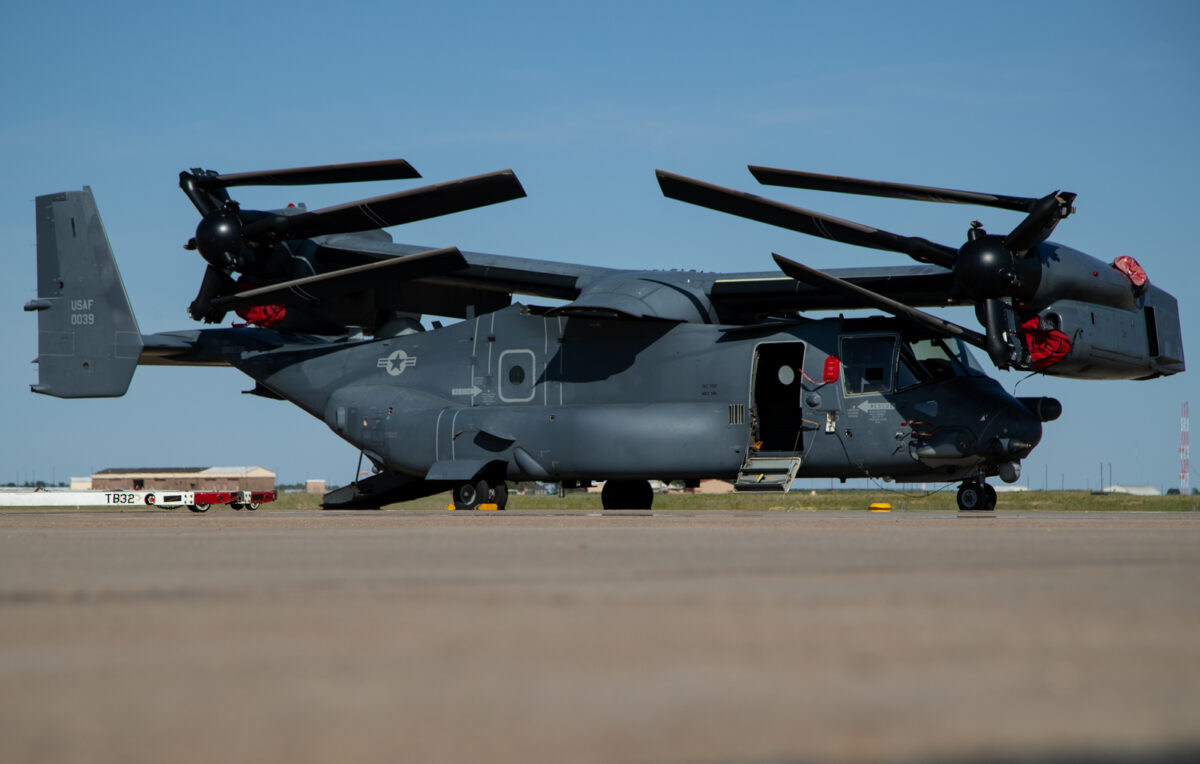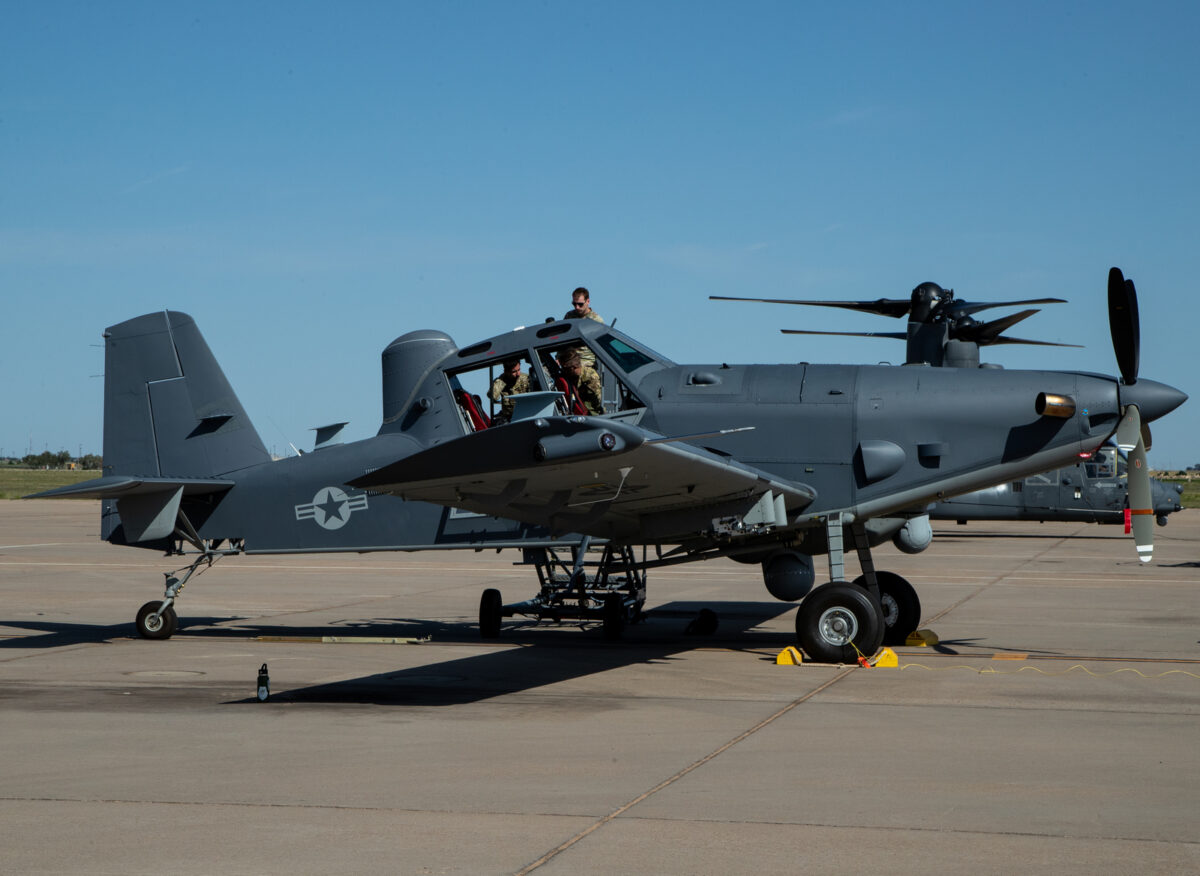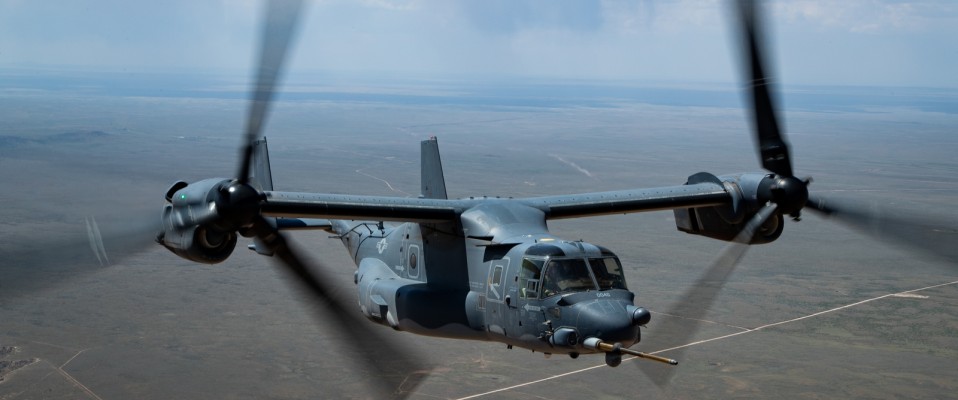Cannon AFB
35 years AFSOC
Report and photos by George Karavantos
November 2, 2025
The US Air Force Special Operations Command is marking its 35th anniversary. George Karavantos visited the 27th Special Operations Wing (SOW), one of the most diversified units of the Air Force, located at Cannon Air Force Base, New Mexico.
Air Force Special Operations Command (AFSOC), headquartered at Hurlburt Field, Florida, is the special operations component of the United States Special Operations Command (USSOCOM), a unified combatant command of all the components, Army, Navy, Marine Corps and the Air Force, which is located at Mac Dill Air Force Base, Florida. AFSOC provides all Air Force Special Operations Forces (SOF) for worldwide deployment and assignment to regional unified combatant commands.
AFSOC was established on May 22 1990, as the Air Force’s component to the United States Special Operations Command. Throughout the years AFSOC has continued to modernize and evolve itself to meet the changing needs of the modern warfare, playing a key role in numerous critical military operations. The 27th SOW is AFSOC’s premier readiness wing. Their mission is to execute unconventional air power anytime, anywhere, while evolving tactics to address growing adversarial threats.
Today, the 27 SOW’s mission is to develop, sustain and employ Air Commandos to continue executing and supporting specialized air power achieving the US’ security objectives. Its role allows operators to pathfind new operational concepts and technologies for the air force and the SOF’s enterprise. Its main three missions are: 1) Alert Posture, 2) Sustained Deployment, 3) Deployed in place operations. They provide mobility, precision strike, intelligence, surveillance and reconnaissance (ISR) and air-to-ground integration.
The unit has a rich history, dating back to the 1940s, which includes countless fighter-bomber aircraft related missions. In 2007, it was redesignated, given a new mission of special operations and equipped with MC-130J and AC-130J model aircraft, CV-22B Osprey, MQ-9 Reaper and U-28A Draco and its newly acquired OA-1K Skyraider II. Those six airframes allow the 27 SOW to play a pivotal role in the global war on terror, permitting highly trained and rapidly deployable airmen to conduct global special operation missions, from precision firepower to infiltration, exfiltration, resupply and refuelling of the Special Operations Forces’ operational elements.

MC-130J Commando II
The MC-130J belongs to the 9th Special Operations Squadron and provides specialized air mobility, executing low visibility operations that include rapid low level infiltration, exfiltration, resupply (by airdrop or airland and refueling missions) in support of special operations forces, in hostile, denied or politically sensitive areas of the world. The MC-130J, first flew in 2011, continues in the lineage of multiple earlier models that provided specialized air mobility, beginning with the MC-130E Combat Talon that executed the Operation ‘Eagle Claw’, continuing with the MC-130P Combat Shadow (a version which also the 9th SOS operated since 1996), that retired in 2015 and the MC-130H Combat Talon II that retired in 2022.
Based on the KC-130J tanker, the MC-130J was the first C-130 specifically built for special operations, making it lighter and more efficient. The Air Force accepted the first MC-130J to Cannon AFB in 2011, with the 13-year delivery program serving as an example of a “quintessential Air Force acquisition program” to develop, field and sustain a specialized capability. The overall AC/HC/MC-130J program began in 2008. The U.S. Air Force in mid-January received the last Lockheed Martin MC-130J Commando II special operations variant of the Hercules, marking the final delivery of the service’s specialized version of the aircraft.
The delivery was the 64th for the MC-130J fleet and the 134th total number of MC-130Js, AC-130Js and HC-130Js. The service still awaits deliveries of new-build C-130Js, but no additional specially modified versions are expected.
While deliveries are completed, the service and U.S. Special Operations Command are conducting upgrades to the MC-130J fleet. These include integration of the Raytheon AN/APQ-187 Silent Knight terrain-following / terrain-avoidance, low-probability-of-intercept / low-probability-of-detection radar, along with a new communication suite, an airborne mission network and radio frequency countermeasure improvements.
AC-130J Ghost Rider
Cannon AFB and its AC-130 operating squadron, the 16th SOS, have a long history with this specialized aircraft. The first AC-130A was delivered to the base in 1968 while the squadron transitioned from the AC-130E, the AC-130H Spectre and the AC-130W Stinger II to the newly acquired AC-130J which was delivered to the base in April 2022 while the AC-130W was retired in July of the same year.
The primary mission of the AC-130J, like all the previous ‘Gunships’, is close air support, air interdiction and armed reconnaissance for special operations and conventional forces around the globe. Close air support includes troops in contact, convoy escort, and point air defense. The AC-130J Ghost Rider is the fifth generation of the AC-130 series and the eighth aircraft to have the ‘Gunship’ title. The concept originated during the Vietnam War from a need to protect remote outposts from attack by enemies who would hide from American airpower in the darkness and jungles. The aircraft’s unparalleled success secured the ‘Gunship’s’ future role as a special operations attack aircraft.
The AC-130J uses a complex weapons suite to employ a 30mm and the unique 105mm guns, as well as AGM-176 Griffin missiles and GBU-39 Small Diameter Bombs. The unique gun fire control system, along with two MX-20 sensors, allows the crew to simultaneously engage two targets, geographically separated by up to one kilometer with separate guns.
It takes two years to become a fully qualified AC-130J Air Commando, starting with undergraduate training, where potential members are identified and assessed based on performance. Once the members are awarded their wings, they are selected for special training in the aircraft. Specific roles and missions for the AC-130J rely on those highly proficient crews that employ artillery and precision guided munitions from the air, to strike targets and/or support ground forces under hostile fire.
The last AC-130J was delivered to USAF in November 2022. The combination of the MC-130J and the AC-130J provides a unique compatibility in terms of logistics, maintenance and equipment that the 27th never had and at the same time provides the best situational awareness for their pilots, a true multi-role combination in the modern battlefields.
CV-22B Osprey
The CV-22 Osprey tiltrotor aircraft which belongs to the 20th Special Operations Squadron, combines the vertical take-off, hover and vertical landing qualities of a helicopter with the long-range, fuel efficiency and speed characteristics of a turboprop aircraft, which brings unique capabilities to the joint force.
As the Commander of the 27 SOW, Col. Robert L. Johnston, admitted to us: ‘The Osprey is the best runway independence aerial asset with unique penetration capabilities that the Air Force ever had’! The specific roles and missions for the CV-22 are being identified as long-range infiltration, exfiltration and resupply missions for special operations forces. Equipped with integrated threat countermeasures, terrain-following radar and forward-looking infrared sensors allow it to operate in various austere conditions but also in politically sensitive or hostile airspaces. Col. Johnston also added: ‘This unique asset along with the MC-130J can offer the 27 SOW unique capabilities of penetration into enemy territories which can be deployed as further as possible’.
The CV-22 is the Special Operation Forces variant of the US Marine Corps MV-22 Osprey. The first two CV-22 test aircraft were delivered to Edwards Air Force Base, California, in September 2000 and AFSOC received its first operational CV-22 in January 2007. This versatile, self-deployable aircraft offers increased speed and range over other rotary-wing aircraft, enabling Air Force Special Operations Command aircrews to execute long-range special operations missions.

MQ-9 Reaper
There are three different squadrons, the 3rd, 12th and 33rd which operate the MQ-9 Reaper medium-altitude, long-endurance (MALE) platform. The MQ-9 Reaper is one of the US Air Force’s remotely piloted aircraft (RPA), employed for its intelligence, surveillance and reconnaissance (ISR) missions.
For more than 20 years, Cannon AFB and the US Air Force have employed pilots and sensor operators to fly RPAs and have continued to grow the community for the Counter Violent Extremism Organization mission. On October 28, 2005, AFSOC reactivated the 3rd SOS, becoming the first RPA unit to fly the MQ-1 Predator in support of Operation Enduring Freedom and Operation Iraqi Freedom. Cannon AFB was operating the MQ-1 Predator for a decade when they were transitioned to the MQ-9 Reaper, which surpassed the MQ-1 in speed, size and ability to carry more equipment and munitions, nearly 10 years ago.
The MQ-9 requires a two-person crew: a pilot and a sensor operator. The MQ-9s operate differently than manned aircraft, since a separate crew, known as the Launch and Recovery Element (LRE), performs the actual take-offs and landings for each aircraft from many locations around the world. The MQ-9 can be controlled from thousands of miles away and can remain airborne for close to 20-22 hours.
The MQ-9’s ability to remain airborne for extended periods allows it to provide an ensuring armed presence over a target or area of interest. Like a constant stare in the sky, the Reaper is a low-risk option for commanders as it operates in areas more difficult for manned aviation and ground forces to reach. AFSOC has developed a rapid alert package that quickly responds to unforeseen crises, allowing the aircraft’s small team anywhere in the world within hours, providing an ‘unblinking eye in the sky’ in support of special operations forces but also for other allies.
U-28A Draco
Another 27 SOW platform that facilitates and supports the spectrum of special operations is the U-28A Draco. The U-28 is flown by the 318th and 310th Special Operations Squadrons and it is a modified Pilatus PC-12 single engine aircraft. This platform conducts intelligence, surveillance and reconnaissance (ISR), command and control (C2) and kinetic strike support operations using a crew of four highly trained Air Commandos.
The U-28 program initially started in 2005 due to urgent need for ISR aircraft supporting counter-insurgency missions. Since then, the aircraft has been continually modified with cutting-edge technology, conducting global counter-terrorism, counter-insurgency and integrated deterrence operations. Most of the intelligence collection sensors of the aircraft are designed specifically for special operations, and its C2 capabilities help bridge communications between Special Operations Forces and conventional forces.
The U-28A plays a critical role in data collection and kinetic activities throughout each phase of counter-terrorism operations. The operational variety of the U-28A makes it highly capable providing tactical ISR support to ground forces while simultaneously conducting kinetic strike support for other aircraft. For this reason, the U-28 has an annual cycle of one major and one minor software modification each year, translating to a continual state of upgrade. Such as upgraded navigations capabilities, engine improvements and innovative IT networks for advanced threat awareness and evolved intelligence systems that have been recently implemented.
‘The U-28 has a legacy in counter-terrorism and counter-insurgency work’, Col. Johnston said. And he continued: ‘SOF units conducting counter-terrorism operations desire Dracos during complex direct-action missions. Our unit’s creativity and adaptability allow us to diversify from the counter-terrorism mission, into irregular and unconventional warfare capabilities.’

OA-1K Skyraider II
The Skyraider II is the newly acquired aircraft of the USAF. It is designed to have the ability to support special operations forces as well as the Joint Force through close air support, precision strike, and armed intelligence, surveillance, and reconnaissance. ‘The OA-1K Skyraider II marks the beginning of a new era in aircraft modulatority for AFSOC. The Skyraider II can adapt capabilities for required mission sets from close air support to precision strike or even reconnaissance. In some cases it can either replace the U-28! The Skyraider II is a dynamic aircraft that will allow operators to adjust effects for required missions and create dilemmas for our adversaries across the spectrum of armed conflict’, told us Col. Johston.
In addition to versatility, the Skyraider II requires a much smaller maintenance package and costs less per flying hour than conventional aircraft or other special operations platforms. AFSOC accepted the first missionized OA-1K Skyraider II on April 3, 2025. The Skyraider II derives its name from the Douglas A-1 Skyraider, which served during the Korean War and Vietnam War. It is developed from the Air Tractor AT-802, an American aircraft that is used for agriculture and fire-firefighting. The AT-802U was officially designated the OA-1K in late 2022.
AFSOC plans to base the OA-1K in Hurlburt Field, Cannon Air Force Base, Davis-Monthan Air Force Base and Will Rogers Air National Guard Base.
George Karavantos is from Athens, Greece. His love with military aviation started at the age of 10 when he accidentally read a Greek aviation magazine. Since then, he never stopped reading about fighter aircraft and taking photos of them. He was too tall to become a fighter pilot, so he became an airline pilot. Nowadays he is a Captain and a Flight Instructor on the A320 aircraft. Despite his profession, military aviation will always be his obsession.

